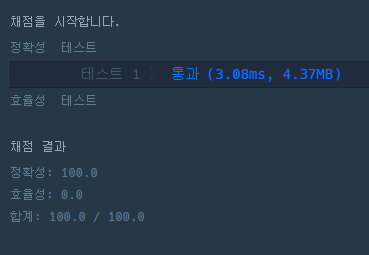문제 푼 날짜 : 2021-08-10
문제
문제 링크 : https://programmers.co.kr/learn/courses/30/lessons/1829
접근 및 풀이
DFS와 BFS를 이용하면 쉽게 풀 수 있는 문제였다.
아래와 같은 알고리즘을 따라 구현하였다.
- 주어진 배열을 탐색하면서 방문하지 않았고 0이 아닌 요소(색)을 찾는다.
- 찾는 순간 영역의 개수를 +1 해주고 그 색과 같은 영역의 크기를 찾는다.
2-1. 지금까지 찾은 영역의 크기 중 가장 큰 크기로 업데이트 해준다.- 1.부터 다시 진행하며 배열을 전부 탐색하면 종료한다.
코드 (DFS)
#include <vector>
#include <cstring>
using namespace std;
struct Point {
int y, x;
};
vector<vector<int>> Picture;
int M, N, cnt;
bool visited[100][100];
int dir[4][2] = {{ 1, 0 }, { 0, 1 }, { -1, 0 }, { 0, -1 }};
void dfs(Point src, int color) {
visited[src.y][src.x] = true;
for (int i = 0; i < 4; i++) {
int nextY = src.y + dir[i][0];
int nextX = src.x + dir[i][1];
if (nextY < 0 || nextY >= M || nextX < 0 || nextX >= N) {
continue;
}
if (visited[nextY][nextX] == true) {
continue;
}
if (Picture[nextY][nextX] != color) {
continue;
}
cnt++;
dfs({ nextY, nextX }, color);
}
}
// 전역 변수를 정의할 경우 함수 내에 초기화 코드를 꼭 작성해주세요.
vector<int> solution(int m, int n, vector<vector<int>> picture) {
M = m, N = n, Picture = picture;
int number_of_area = 0;
int max_size_of_one_area = 0;
memset(visited, false, sizeof(visited));
for (int i = 0; i < M; i++) {
for (int j = 0; j < N; j++) {
if (visited[i][j] == false && Picture[i][j] != 0) {
number_of_area++;
cnt = 1;
dfs({ i, j }, Picture[i][j]);
max_size_of_one_area = max(max_size_of_one_area, cnt);
}
}
}
vector<int> answer(2);
answer[0] = number_of_area;
answer[1] = max_size_of_one_area;
return answer;
}코드 (BFS)
#include <vector>
#include <queue>
#include <cstring>
using namespace std;
struct Point {
int y, x;
};
int dir[4][2] = {{ 1, 0 }, { 0, 1 }, { -1, 0 }, { 0, -1 }};
vector<vector<int>> Picture;
int M, N;
bool visited[100][100];
int bfs(Point src, int color) {
int cnt = 1;
queue<Point> q;
q.push(src);
visited[src.y][src.x] = true;
while (!q.empty()) {
Point now = q.front();
q.pop();
for (int i = 0; i < 4; i++) {
int nextY = now.y + dir[i][0];
int nextX = now.x + dir[i][1];
if (nextY < 0 || nextY >= M || nextX < 0 || nextX >= N) {
continue;
}
if (visited[nextY][nextX] == true){
continue;
}
if (Picture[nextY][nextX] != color) {
continue;
}
q.push({ nextY, nextX });
visited[nextY][nextX] = true;
cnt++;
}
}
return cnt;
}
// 전역 변수를 정의할 경우 함수 내에 초기화 코드를 꼭 작성해주세요.
vector<int> solution(int m, int n, vector<vector<int>> picture) {
M = m, N = n, Picture = picture;
int number_of_area = 0;
int max_size_of_one_area = 0;
memset(visited, false, sizeof(visited));
for (int i = 0; i < M; i++) {
for (int j = 0; j < N; j++) {
if (Picture[i][j] != 0 && visited[i][j] == false) {
number_of_area++;
max_size_of_one_area = max(max_size_of_one_area, bfs({ i, j }, Picture[i][j]));
}
}
}
vector<int> answer(2);
answer[0] = number_of_area;
answer[1] = max_size_of_one_area;
return answer;
}결과


피드백
DFS, BFS를 손쉽게 구현할 수 있도록 반복 숙달하도록 하자.
